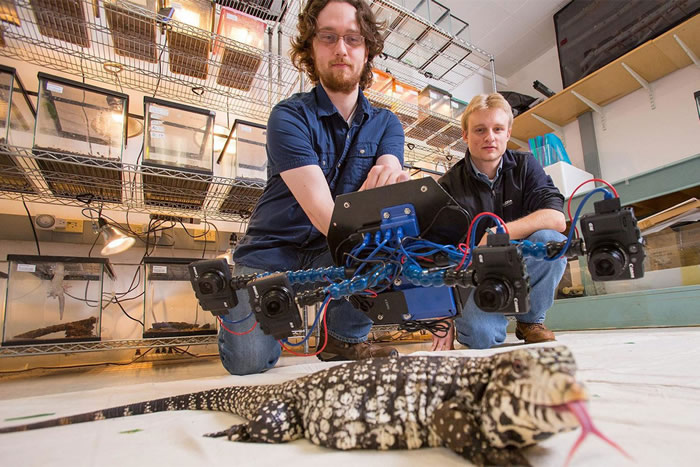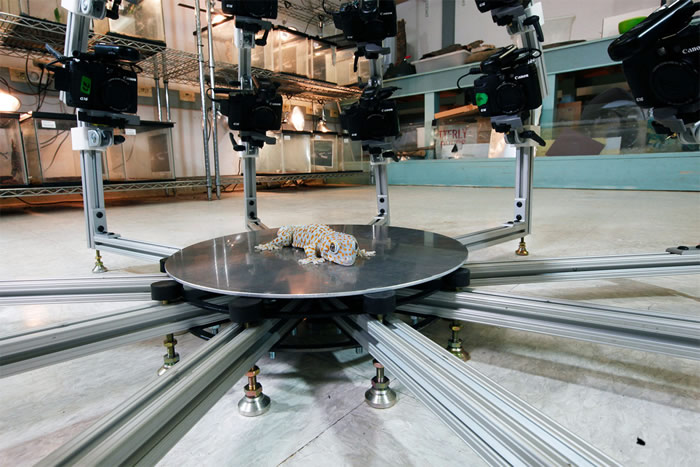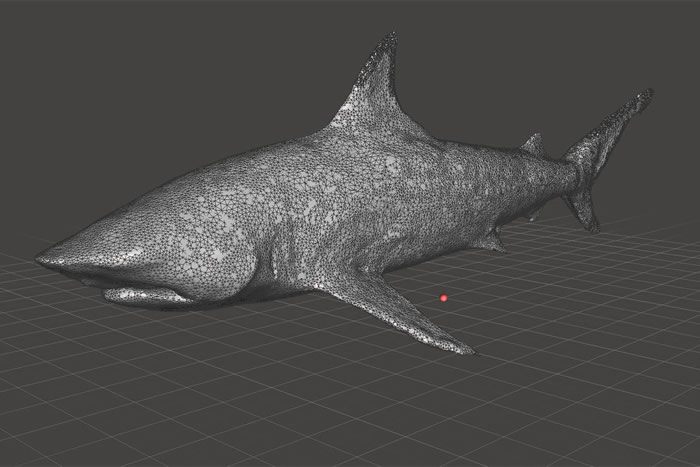Cataloging not killing: Enter the Beastcam
Biologist Duncan Irschick helped create Geckskin, a super-adhesive that mimics the mechanics of gecko feet, a few years ago. In January, he developed the Beastcam, a portable camera array that can snap high-resolution, full-color 3D images of living organisms.
Now, the University of Massachusetts Amherst researcher is leading one of the most ambitious imaging initiatives around — 3D modeling every living species on Earth and publishing the data through Digital Life.
“In the field, people often have to kill an animal to preserve it,” Irschick tells Digital Trends. “With our 3D models, the animal can stay alive.
“If you discovered a new species in the wild, how fantastic would it be if you could create a 3D model of the living animal right there,” he asks, “capturing it’s color, shape, and posture?”
The Beastcam array consists of 30 cameras, three on each of its 10 arms. The device takes 30 simultaneous snapshots and uses software to stitch them all together into a 3D representation.
“The current system is designed for smaller animals who pose really well for photographs,” Irschick says, listing frogs and geckos as particularly good subjects. “So the current range is from about three-and-a-half inches to 10 inches, but in the next several months we’ll have the capacity to capture animals from half an inch to six feet or more.
When imaging larger creatures like sharks in more precarious environments outside the lab, Irschick and his team turn to a handheld Beastcam, which they sweep around the specimen manually.
“Our plan is to adapt this technology to a variety of animals” says conservation photographer Christine Shepard, who helps lead the initiative. “We’re looking at a number of animal groups — at their shape and mobility — and working with our multidisciplinary team to adapt this technology to best fit each type of group.”
Nine 3D models are available on the Digital Life website, including an emperor scorpion, horned frog, and birch fungus. “As far as I’m aware, ours is the only high-resolution 3D shark model,” Irschick says. Each can now be viewed in virtual reality, with dozens more models and exportable 3D printing files on the way. Over the next year, Irschick thinks they’ll have captured images of hundreds of species.
But each species is unique and every specimen has its quirks. One size won’t fit all. “Some sharks are really fat,” Irschick says, “and others are really skinny. We want to capture that.” By developing versatile Beastcams, the researchers hope to tailor their technology to the particular species and specimens they’re imaging.
The initiative insists on ethical handling of animals, so it aims to image live specimens only when they’re already being handled for parallel scientific study, which Shepard says sets the project apart from others.
These models also have significant scientific value, she says, as highly-accurate depictions of living creatures are rare. Along with the models, the researchers will record metadata on measurements, locations, and species information, which can be accessed for further research.
And these models may help wildlife conservation groups engage the public in novel ways, with 3D printed objects and virtual reality to spark the interest of potential donors.
Finally — and perhaps most promisingly — is the project’s educational potential. “We can create this virtual biology lab of the future where students can interact with animals that they otherwise wouldn’t get to see in real life due to geographic restraints or the rarity of the animal,” Shepard says. “We’re really hoping to increase access to valuable species and empower students to learn in an interactive way.”
Over the next year, Irschick and his team will be traveling around the world thanks to support from the National Science Foundation. From the Philippines in May to Florida in June, they’ll partner with field researchers to image endangered species of toads and sea turtles before moving on to more complicated creatures. Along the way they’ll continue to test and adapt their imaging techniques for their future subjects.
It may take generations to image the nearly trillion species thought to exist on Earth, but every species that’s captured is a species that’s digitally preserved.
More information: Digital Trends





Comments are closed, but trackbacks and pingbacks are open.